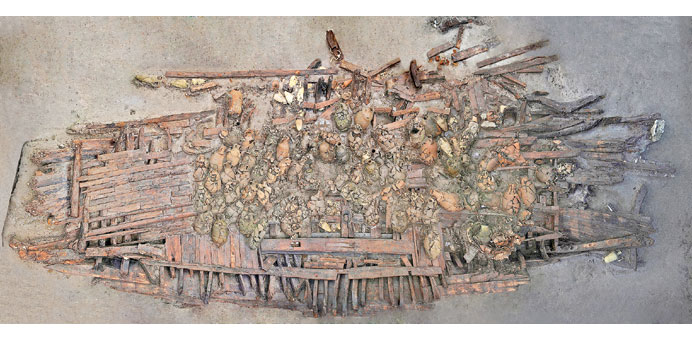37 shipwrecks discovered underwater during the Marmaray subway construction in Istanbul’s Yenikapı threw new light on the region’s history. Photo courtesy of the Archive of Istanbul Archaeological Museums
By Anand Holla
Passing under the Bosphorus Strait, Turkey’s Marmaray tunnel is the world’s first, connecting two continents. But what lay beneath and around one of the busiest shipping arteries might fascinate you to no end.
Tomorrow at the Museum of Islamic Art Auditorium at 6pm, in a lecture titled “The Marmaray Project: Preventive and Rescue Archaeology Strategies in Turkey”, Zeynep Kızıltan, Director of Istanbul Archaeological Museums, will talk about all of that and her approach to rescue archaeology during major infrastructure projects, an issue “that is of particular relevance in Qatar as work proceeds on Doha’s mega development projects.”
Sometime in 2005, work on a new metro in Istanbul was caught unawares by “an astonishing archaeological discovery”, says a note by the Qatar Museums (QM) on the event. Excavations uncovered evidence of the city’s largest harbour, the 4th century Harbour of Eleutherios – later known as the Harbour of Theodosius – parts of the city wall of Constantine the Great, and the remains of several ships including the only ancient or early medieval galley ever discovered, the note further points out.
“The site also revealed traces of human settlement in Istanbul, dating back 8,000 years, causing a radical revision of the history of the ancient city and its Hellinistic, Roman, Byzantine and Ottoman past,” the note says. Kızıltan, between 2004 and 2014, conducted the Rescue Excavations of Marmaray and Metro Projects, counted among the most important transportation projects in Istanbul inside the protected “historical peninsula”. In her lecture, Kızıltan discusses this amazing site, among other issues.
The event is the second in a six-part lecture series on Archaeology and Heritage Conservation organised by Qatar Museums and the Ministry of Culture and Tourism of Turkey in partnership with UCL Qatar (UCL-Q) as part of Qatar Turkey 2015 Year of Culture. The series introduces to Doha “the work of key Turkish experts in the fields of Archaeology and Heritage Conservation.”
Aimed at students, faculty staff and general audiences, the informal lectures and talks are scheduled for October and November at the MIA auditorium and in the UCL-Q Auditorium in Education City.
At the Istanbul Archaeological Museums, Kızıltan has played an active role in preparation and publication of a host of exhibitions and their catalogues in Turkey; from “Woman in Anatolia, 9000 Years of Anatolian Woman” (1993), to “Stories from the Hidden Harbor, Shipwrecks of Yenikapı” (2013).
A note shared by Dr Ferhan Sakal, Consultant – Head of Archaeology Operations, Qatar Museums, talks about how in 2004, when the Istanbul Archaeological Museums started large-scale salvage excavations at Yenikapı, within the scope of Marmaray-Metro projects, archaeological excavations were conducted at one of its Byzantine harbours for the first time in the city’s history.
“When the excavations started, it was not known what this ancient harbour at the mouth of the Lykos (Bayrampasa) River would yield. At first, Ottoman remains were encountered in the excavation area, which covers more than 58,000 square meters. Then, one of Constantinople’s most important, and the world’s best known harbours, the Theodosian Harbor, was reached only 1 meter below sea level,” the note explains.
The subsequent excavations would unearth countless small finds and works of architecture. “In addition to wood and rope fragments, an unexpected find, a shipwreck, was found in 2005. As the excavation area expanded, a total of 37 ships dating between the 5th and 11th centuries were brought to light. Among the finds are very well-preserved small and large merchantmen, as well as galleys from the Middle and Late Byzantine periods, which have been found for the first time. The Yenikapı wrecks constitute the largest collection of shipwrecks ever found together,” the note points out.
One of the many surprises that awaited the archaeologists rested 6.3 m below sea level: Istanbul’s oldest settlement. A Neolithic settlement that dated 8000 years back, and a few meters below, “the footprints of Istanbulites who lived there thousands of years ago” were found.
Kızıltan’s lecture will be held in Turkish with simultaneous translation in English and Arabic, and admission is free.



